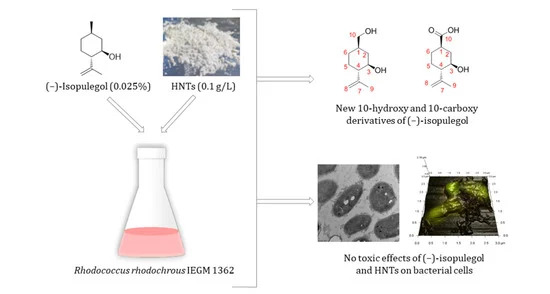The article with participation of NIOCh's researchers is published in Journal Pharmaceuticals (IF 5,215)
Biotransformation of (–)-Isopulegol by Rhodococcus rhodochrous
Irina B. Ivshina, Natalia A. Luchnikova, Polina Yu. Maltseva, Irina V. Ilyina, Konstantin P. Volcho, Yurii V. Gatilov, Dina V. Korchagina, Nadezhda A. Kostrikina, Vladimir V. Sorokin, Andrey L. Mulyukin and Nariman F. Salakhutdinov 
Abstract
The ability of actinobacteria of the genus Rhodococcus to biotransform the monoterpenoid (–)-isopulegol has been established for the first time. R. rhodochrous strain IEGM 1362 was selected as a bacterium capable of metabolizing (–)-isopulegol to form new, previously unknown, 10-hydroxy (2) and 10-carboxy (3) derivatives, which may presumably have antitumor activity and act as respiratory stimulants and cancer prevention agents. In the experiments, optimal conditions were selected to provide the maximum target catalytic activity of rhodococci. Using up-to-date (TEM, AFM-CLSM, and EDX) and traditional (cell size, roughness, and zeta potential measurements) biophysical and microbiological methods, it was shown that (–)-isopulegol and halloysite nanotubes did not negatively affect the bacterial cells. The data obtained expand our knowledge of the biocatalytic potential of rhodococci and their possible involvement in the synthesis of pharmacologically active compounds from plant derivatives. View Full-Text
Keywords: biotransformation; halloysite nanotubes; (–)-isopulegol; monoterpenoid; Rhodococcus rhodochrous
Альметрики:


